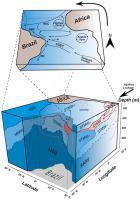Deep Sea Research Part I: Oceanographic Research Papers ( IF 2.3 ) Pub Date : 2020-11-20 , DOI: 10.1016/j.dsr.2020.103450 Elias Azar , Andres Piñango , Mônica Wallner-Kersanach , Rodrigo Kerr

|
This study reveals the influence of the Subtropical Mode Water (STMW) varieties and their spatiotemporal variability on the upper thermocline of the tropical Atlantic Ocean. Optimum Multiparameter water mass analysis was applied using the hydrographic and chemical datasets available from the World Ocean Database 2018 and The Global Ocean Ship-Based Hydrographic Investigations Program. Eighteen Degree Water (EDW) and Madeira Mode Water (MMW), sourced in the northwest and northeast North Atlantic, respectively, contribute to the North Atlantic Central Water (NACW) layer, which follows the North Equatorial Current and setting up the limit with the South Atlantic Central Water (SACW) at about 10°N. The contribution of the EDW to the NACW spreads at the surface layer (excluding the first 100 m) until the 26.6 kg m−3 isopycnal (~250 m). MMW contributes to denser levels of the upper layer, mainly between 26.8 and 27.0 kg m−3 (300–700 m). In the southern hemisphere, mode waters formed in the eastern South Atlantic (STMW18) and along the edge of the subtropical front (STMW12) were the main contributors to the surface and denser levels, respectively. The variety formed in the Brazil-Malvinas confluence (STMW14) was restricted to the southwestern side of the South Atlantic gyre, while the Subtropical Indian Mode Water (STIMW; mode water advected from the Indian Ocean into the South Atlantic Ocean) influenced the SACW structure between 20°S and 30°S with an averaged mixing fraction of ~34% ± 20%, mainly at isopycnals of 26.2 and 26.4 kg m−3 (100–400 m). The main source of the STIMW, the Agulhas eddies, act as interocean exchange structures that transport an average of 5.5 ± 3.2 Sv (1 Sv = 106 m3 s−1) of STIMW to the Atlantic, even after they have been altered by splitting and/or merging processes. In addition, a smaller contribution of ~20% of STIMW was associated with the North Brazil Current at ~350 m, showing the interhemispheric connection between the Indian Ocean and the upper branch of the Atlantic Meridional Overturning Circulation. Therefore, due to the previously reported increase of the Agulhas leakage and the dynamic of the southern Equatorial Current bifurcation, the heat and salt fluxes to the northern hemisphere may likely increase in the following years.
中文翻译:

源水对热带大西洋中央层的贡献:关于印度-大西洋交往的新见解
这项研究揭示了亚热带模式水(STMW)品种及其时空变化对热带大西洋上层高温跃层的影响。使用可从2018年世界海洋数据库和基于全球海洋船的水文调查计划中获得的水文和化学数据集进行最佳多参数水质分析。分别来自北大西洋西北部和东北部的十八度水(EDW)和马德拉模式水(MMW)为北大西洋中央水(NACW)层做出了贡献,该水层遵循北赤道潮流,并通过南大西洋中央水域(SACW)在约10°N。EDW对NACW的贡献一直扩展到表层(不包括前100 m),直到26.6 kg m -3等渗(〜250 m)。MMW有助于上层的致密水平,主要在26.8至27.0 kg m -3(300-700 m)之间。在南半球,分别在南大西洋东部(STMW 18)和亚热带锋面(STMW 12)边缘形成的模态水分别是地表水和致密水平面的主要贡献者。巴西-马尔维纳斯交汇处(STMW 14)形成的变种仅限于南大西洋回旋区的西南侧,而亚热带印度模式水(STIMW;从印度洋流入南大西洋的模式水)影响了SACW在20°S到30°S之间的结构,平均混合比为〜34%±20%,主要在26.2和26.4 kg m−3(100–400 m)。STIMW的主要来源是Agulhas涡流,它是海洋间交换结构,即使将它们平均改变了5.5±3.2 Sv(1 Sv = 10 6 m 3 s -1)到大西洋,也将其运输到大西洋。拆分和/或合并过程。此外,约350%的STIMW贡献较小,与约350 m处的北巴西洋流有关,表明印度洋与大西洋子午向翻转环流上支之间存在半球间联系。因此,由于先前报道的Agulhas泄漏量增加以及南赤道流分叉的动态,在接下来的几年中,北半球的热量和盐通量可能会增加。











































 京公网安备 11010802027423号
京公网安备 11010802027423号